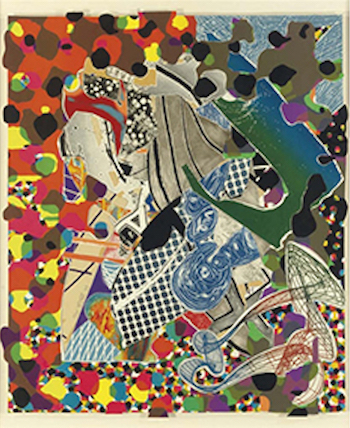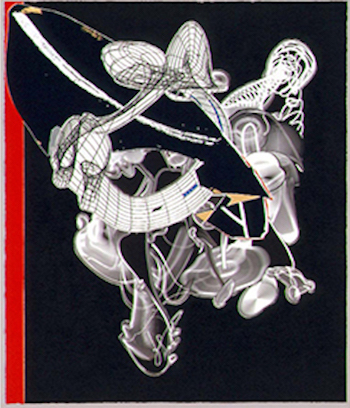Visual Arts Review: Stella Prime — Prints from an American Master
The stunning show Frank Stella Prints offers visual entertainment at its most exhilarating.
Frank Stella Prints, organized by the Madison Museum of Contemporary Art in Wisconsin and curated by Richard H. Axsom. On view at the Addison Gallery of American Art, Andover, MA, through July 30.

“Star of Persia” (1967), from the Star of Persia Series by Frank Stella, Lithograph on English graph paper. Photo: Addison Gallery of American Art.
By Mark Favermann
Frank Stella Prints offers an unusually illuminating perspective on the career of virtuoso artist Frank Stella, who helped define the perimeters of American art over the past five decades. The show focuses on his printmaking, and its over 100 works on paper suggest the ways his highly experimental approach transformed our understanding of the traditional print.
This elegant and comprehensive exhibition, the artist’s first major print retrospective since 1982, also offers up a clear view of Stella’s stylistic evolution — a series of reinventions that morphed from the minimalist geometric abstraction of his early years to an effervescent complexity of his later gestural work.
Raised in Malden, Massachusetts, the son of an Italian-American doctor, Frank Stella confesses that he was a bit rambunctious in his early youth. His family sent him away to Phillips Academy Andover (Class of 1954) “to settle down.” The art exhibited at the privileged school’s gallery intrigued him; Stella began to develop his artistic skills while at the institution. After matriculating to Princeton University, he further honed his talent, to the point that he decided to become a professional artist. In the late ’50s he made his mark with his minimalist and geometric “Black Paintings.” From there his work slowly underwent a transformation — from a single-minded focus on the stark and flat to an embrace of vibrant, colorful, and joyous gestures.

“Talladega Five I,” (1982) combination relief and woodcut on paper by Frank Stella. Photo: Addison Gallery of American Art.
For over fifty years, the immensely influential Stella has created a significant body of abstract art that includes paintings, reliefs, sculptures, drawings, and prints.
Early on in his career, Stella’s paintings directly informed his approach to printmaking. Through the use of lithographs, Stella creatively rephrased his paintings, both in terms of color and scale. By the ’80s, the imagery in the prints, though still mirroring the direction of the artist’s paintings, became more independent. The prints also began to incorporate experimental materials, following in the footsteps of Stella’s paintings. In many ways, his work during this period expanded the notion of what a print could be. And Stella acknowledges that, eventually, there was a creative reversal: his prints began to inform the direction of the paintings. The visceral quality of Stella’s later paintings and sculpture reliefs are inspired by the imagery and production processes of his prints.
Stella’s printmaking experimentation led to him to try out increasingly literal (and creative) variations on the print media itself. He began to combine lithography, screen printing, intaglio, and woodcuts on handmade paper. He constructed collages from discarded color trial proofs created for previous print series, as well as for current efforts. Scrap metal discarded from Stella’s relief paintings and other sculptural creations were assembled together to create plates for printing. The almost visceral quality of Stella’s later paintings and sculpture reliefs are strongly intertwined with the imagery and production processes of his prints.

“A Bower in the Arsacides” (1993) by Frank Stella, lithograph, etching, aquatint, relief, collagraph on white TGL, handmade paper. Photo: Addison Gallery of American Art.
Interestingly, Stella collaborated with master printer Kenneth Tyler on the majority of his prints. Tyler is considered by many critics to be the most technologically innovative artwork printer of the past century. Stella and he seemed to be perfectly matched in terms of their imaginations and creative interest in technology. When Tyler Graphics Limited closed in 2001, Stella stopped making prints.
This exhibit features many of the artist’s most important print series. Stella’s titles reflect the imagery in his work — they are rich in meaning, at times tending toward the allegorical. Their ambitious resonances range from the personal to the historical, from the geographical to the political. His titles refer to 19th Century American clipper ships, Civil War battles, endangered or extinct birds, Formula 1 racetracks, Italian folktales, and Herman Melville’s epic novel Moby Dick. The exhibition includes works from Black Series I (1967), Exotic Birds (1977), Circuits (1982-83), Swan Engravings (1982-85), Moby Dick Engravings (1991), Imaginary Places (1994-99), Near East Monopoly (1999-2001), and Stella’s last print offering, The Schwarze Weisheit Series (Black Wisdom) (2000). Once the ’80s arrived, Stella’s prints began to embody his emerging interest in what he refers to as “abstract narration.”
From his earliest prints on, Stella was concerned with telling an abstract yet somehow personal story. His ’60s prints range from rectilinear geometric abstractions done in black, brown, or other monochrome variations to multicolor patterns that reflect his (now classic) pattern paintings of the period. Star of Persia II (1967) proffers a wonderful example of this style. Double Gray Scramble (1973) offers another look at Stella in his prime.

“Schwarze Weisheit for D.J.,” (2000), by Frank Stella, lithograph, etching, aquatint, relief and embossing on paper. Photo: Addison Gallery of American Art.
The combination relief and woodcut Talladega Five I (1982) shows us Stella breaking out of formal geometry and moving into a more playful exercise in line and movement organized by imaginary diagrams. In the 1993 print Bower in the Arsacides the artist references a chapter in Moby Dick: it is an image of Ishmael peeling back the skin of a whale. Schwarze Weisheit for D.J. (2000) seems to allude to the ‘magical’ qualities of X-rays and MRIs. We are invited to peer deep into the guts of the image, to probe its abstract reality, perhaps even glimpse its elusive ghost.
Stella’s inventive and poetic imagination is uppermost in this exhibit. It is apparent in the graceful complexity of the artist’s lines, shapes, and tools (given its presence in a number of configurations, he loves the shape of the protractor). His masterful artistic sensibility and skill are obvious in his adroit use of monochrome, vibrant sometimes confectionary colors, and black and white. And it is present in a restless experimentation that makes this artist a groundbreaking printmaker. Frank Stella Prints offers visual entertainment at its most exhilarating.
Frank Stella Prints is accompanied by The Gifts of Frank Stella, an exhibition that highlights works donated by the artist to the Addison Gallery — pieces created by his contemporaries as well by himself. This companion exhibit offers a splendid opportunity to take an informed visual tour of contemporary art during the second half of the 20th century.
An urban designer, Mark Favermann has been deeply involved in community branding, enhancing, and making more accessible parts of cities, sports venues, and key institutions. Also an award-winning public artist, he creates functional public art as civic design. Mark created the Looks of the 1996 Centennial Olympic Games in Atlanta, the 1999 Ryder Cup Matches in Brookline, MA, and the 2000 NCAA Final Four in Indianapolis. The designer of the renovated Coolidge Corner Theatre, he has been a design consultant to the Red Sox since 2002. Mark writes on architecture, design, and the fine arts.
Tagged: Addison Gallery, Frank Stella, Frank Stella Prints, Mark Favermann

This was a succinct and lucid recap of Stella’s printing career.
Can you tell me how many Artis’s Proofs were made in the printing of A Bower in The Arsacides,1993 print?
Many thanks,
Bette Klegon